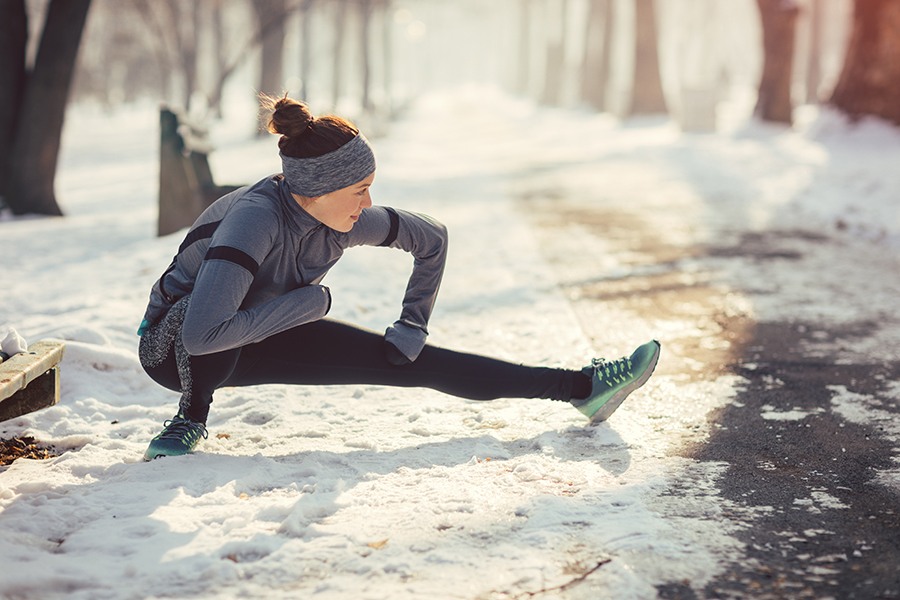The Best Cold Weather Running Gear and Clothing to Buy This Season
Be prepared for the New England cold this winter with this essential list of cold weather running gear.

Photo via Getty Images
When it comes to running, the less clothing the better. You want to be as aerodynamic as possible, and the more gear you’re towing around, the more energy you’re going to have to exert. During a Boston winter, though, you don’t have much of a choice. If you want to continue running outside, proper cold weather running gear is essential.
Don’t get me wrong: We have enough beautiful and high-tech indoor running studios in Boston to satisfy any racers’ need. But there’s just something special about the great outdoors and the fresh wind on your face that can’t be found in the sterile environment of a gym on a pulsating treadmill.
With my knowledge of the Boston running scene, and the collected racing expertise of various other Boston staffers (Boston Marathon finishers and lifelong runners themselves), we came up with this list of essential cold weather running gear you surely can’t leave the house without this winter. Unless you fancy frostbite on your toes and wind burnt cheeks—then, even more power to you, because you’re crazy, but probably one hell of a runner.
1. Headlamp
Tom Stackpole, senior editor here at Boston, says if you want to run in the winter, a headlamp is one of the most essential things you need. After all, it does get dark by 3:30 p.m., so if you like logging your miles in the evening, it’s imperative that you can see and be seen—especially with the way we like to drive here in Massachusetts.
Where to buy: It doesn’t need to break the bank—this one on Amazon would do just fine. Runner’s World also has a comprehensive list of headlamps to purchase. Locally, Marathon Sports has a whole selection of reflective apparel like vests, arm bands, and foot lights.
2. Face mask and/or a hat
You’ll want to protect your head and your face from the cold with material that is both light and moisture wicking, but heavy enough to keep the heat in. Michaela Quigley, associate research editor at Boston, wears buffs, or long neck warmers that can be worn as a headband or a face mask. They are a great option as both the weather and your body temperature change, so you can adjust accordingly.
Where to buy: Marathon Sports has Kari Traa tubes made from Merino wool to provide insulation while wet and dry. They also have winter hats and headbands. Or try local Jangi for neck warmers and hats with funky designs.
3. Running tights or leggings
Protect the most important body part while you run: Your legs! Stackpole says it’s not imperative to invest a ton of money in your leggings, but they are one of those items of clothing that can be extremely versatile, so it’s not a terrible idea to spend an extra penny. Quigley prefers the fleece-lined ones.
Where to buy: When it comes to clothing, trust the pros at Nike Boston. All of Nike’s running tights and leggings feature Dri-Fit fabric to wick sweat away from the skin.
4. Gloves and hand warmers
While your legs are doing most of the work, your arms and hands might be a little more exposed to the elements. While most any gloves will do, keep your fingers happy with hand warmers, and don’t forget to move them around every once in awhile.
Where to buy: These Inverno gloves from Tracksmith are touchscreen compatible at the fingertips, so you don’t have to worry about fumbling in and out of the finger holes to change your music or pause your run tracking app. Hand warmers can be found at convenience stores or grocery stores.
5. Wool running socks
Look for Merino wool when you’re purchasing your running socks, and material that will stay dry like nylon. Stackpole says Smartwool socks have been a revelation for his training. Balega socks are also a great option, as they come in heavier duty materials and fit perfectly to the mold of your foot.
Where to buy: Marathon Sports has a wide selection of socks, including brands such as Balega and Brooks. New Balance also has their own line of trail socks engineered for optimal arch support, comfort, and warmth.
6. Trail shoes or crampons
When New England throws the elements at you, be prepared to run in them—snow and ice shouldn’t deter you, unless you’re not properly outfitted with the appropriate shoes. Normal running shoes won’t cut it through slush and precipitation. Look for lightweight trail running shoes with traction on the outsole and a waterproof upper. Quigley says she has friends who use crampons, but those are probably better suited for places like the Blue Hills or Middlesex Fells and less for those just sticking to city streets.
Where to buy: Stackpole recommends Innov8’s. For local options, try the Reebok All Terrain Craze shoes or Marathon Sports’ wide selection of trail running shoes.
7. Lightweight, but durable running jacket
It’s all about layering when it comes to winter running. On top you’ll want a base layer, like a running tech long-sleeve, and either a jacket or vest over that. Quigley opts for a running vest to keep her arms free, but Stackpole likes the feel of a lightweight jacket that insulates some heat. It comes down to personal preference, though, so see what works best for you. And remember: You can always take layers off, but it becomes a little hard to add layers when you’re two or three miles deep into a run and you’re suddenly freezing.
Where to buy: Try New Balance’s Radiant Heat vest or jacket featuring a puffer construction and heat technology insulation. Heartbreak Hill Running company also has a selection of windbreakers and jackets for men and women that come in a variety of colors and designs.


